IT’S ALL ABOUT TRAINING

Ophthalmic professionals believe they would benefit from greater opportunities for training in clinical skills or practice management techniques. That’s one of the interesting takeaways from Ophthalmic Professional’s 9th Annual Salary Survey and industry trends survey.
The survey was conducted earlier this year and revealed trends on several topics, including salary and benefits, the work environment, professional training, and continuing education. About 300 qualified respondents replied, most of whom were ophthalmic technicians (44%) (Figure 1).
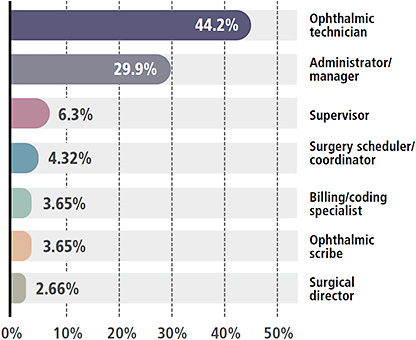
Other takeaways include:
- Overall, the allied health field in eyecare remains a stable workplace. Nearly 75% of respondents have worked in the field for 11 years or more, and 46% for 21 years or more (Figure 2).

Figure 2. How long have you worked in an ophthalmic-related position?
- In general, salaries have increased, with 60.8% reporting they received a raise in the past year.
- While the training needs may vary by position, two of the top needs identified were education in practice management and diagnostic equipment.
Survey methodology
The Ophthalmic Professional Reader Survey was conducted online beginning on Mar. 28, 2023. Email invitations, which included a link to the survey, were sent to subscribers only. OP received 350 total responses. Of those, 53 respondents were disqualified, as they did not indicate they maintain a full-time allied health position in a U.S. ophthalmology practice. The survey closed on April 18, 2023. All individual responses are confidential.A salary snapshot
More than half (54.1%) of the respondents report earning between $40,001 and $70,000 (Figure 3); 37.7% report earning more than $70,000, and 15.4% report earning $40,000 or less. Last year, 54.7% reported earning between $40,000 and $70,000, 26.1% reported earning more than $70,000, and 19.2% earned less than $40,000.
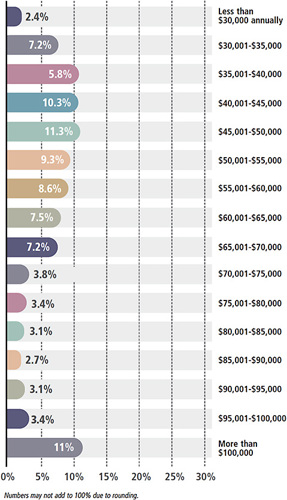
Of course, salaries vary greatly among several factors, including location, practice size, and position. For example, according to 2023 survey data, the average administrator or manager earns between $75,000 and $95,000 per year. The median salary for administrator — the 50th percentile, or point at which half of workers earn more and half earn less — falls in the range of $85,000 to $90,000 (Figure 4).
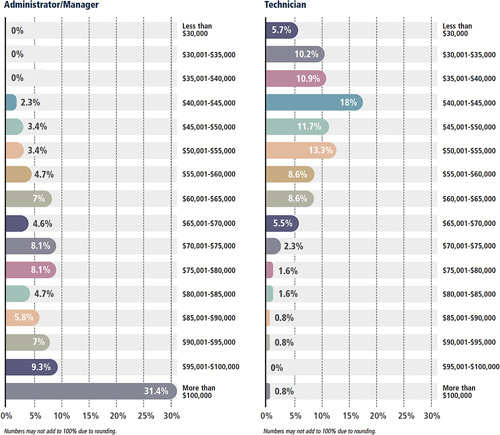
The median salary for a technician falls in the $45,000 to $50,000 range (Figure 4).
About six in 10 respondents reported receiving a salary increase in the previous year, with most (69.5%) of those raises 5% or less.
“A raise of about 3% has pretty consistently been the norm in this field for years,” notes Jane T. Shuman, MSM, COT, COE, OCS, OSC, president of Eyetech’s and co-editor of OP.
Ms. Shuman suggested that inflation, which exceeded 8% during most of 2022, may have contributed some leaving their positions. “There’s a lot of chatter on social media that their pay is not commensurate with cost of living,” she says.
While some practices may feel compelled to provide larger raises to retain talented staff, others may be reluctant due to declining rates of reimbursement.
Delivering more than salary
Salary represents just one portion of the compensation picture, as practices offer a number of benefits to attract and maintain staff. About 94% of respondents report receiving medical insurance, followed by dental insurance (85%), a qualified retirement plan (71.1%), vision insurance (64.7%), long-term disability insurance (62.9), and HSA/HRA and flexible spending (58.9%)
Practices also offer non-monetary benefits that can affect not only overall compensation, but may also job satisfaction. These include paid vacation/sick/personal time (98.7%), training/assistance with professional development (50.%), flexible work schedule (37.4%), and paid lunches/meals (19.1%), among others.
Certification and training: A significant benefit
Most practices offer reimbursement for certification and education. Respondents said their practices reimburse employees for certification (76%), recertification (71%), and/or continuing education (70%). This impacts compensation as advanced certification may offer opportunities for higher salaries. For example, 29.4% of certified ophthalmic assistants reported earning more than $60,000, whereas 45% of certified ophthalmic technicians reported earning more than $60,000.
“My experience anecdotally, in working with clients across the country, most practices are happy to do the things they need to do to maintain clinical standards, such as certifications or recert,” says Laura Baldwin, an expert on employee recruitment and retention with BSM Consulting in Phoenix, AZ. “Other than that, they’ll begrudgingly provide some training on an as-needed basis, but it’s not a proactive investment in continuing education in multiple areas of practice management and leadership.”
Judy Williams, president and CEO of BSM Consulting and co-editor of OP, agrees, adding that “the really good practices go above and beyond, doing more of the practice management and other training that is more discretionary.”
“In tougher economic times, there can be a temptation to reduce training budgets, which can have unfortunate consequences on staff performance, retention, and ultimately, patient satisfaction,” she notes.
Understanding training needs
A breakdown of the data shows that training needs vary, depending on the respondent’s role. Among those in administrative or management positions, 79% identified practice management as an area where they would like more training, far ahead of diagnostic (35%) or surgical (17%) equipment, pharmaceuticals (30%), or training in the use of technology such as electronic medical records (EMR) systems (34%) (Figure 5).
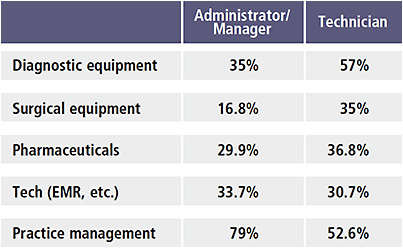
Darrin Landry, CRA, OCT-C, FOPS, manager, Diagnostic Imaging at Eyecare Medical Group in Portland, ME, agrees. “It makes sense that administrators or managers who were polled indicated a need for management training above all else. Promotion of existing technical or administrative staff to the role of manager in a practice is commonplace. While these new managers may have the clinical background and experience, a lot are ill prepared for the spectrum of duties and different skill set that this new role requires,” he says.
Ophthalmic techs, meanwhile, said they desire training in diagnostic equipment (57%), followed by practice management (53%), pharmaceuticals (37%), surgical equipment (35%), and EMR or telemedicine platforms (31%) (Figure 5).
“Staff shortages have resulted in technicians wearing multiple hats in a clinical environment, and training on unfamiliar equipment that results in diagnostic information is a priority,” says Mr. Landry. “Ideally, formal training with an expert, along with hands-on practice should be the standard.”
“What I have found since COVID is that the greatest need is clinical training for new staff,” adds Ms. Shuman. Other areas include the payment system. “Clinical staff see the billables go out and say, ‘the doctors are making so much money,’ but don’t understand the contracts, the write-off, and the fact that reimbursements are declining.”
Varied training resources
Respondents reported using a variety of sources for training or education. The largest group (64%) said they received training through professional organizations like the American Society of Ophthalmic Administrators (ASOA) or the International Joint Commission on Allied Health Professionals in Ophthalmology (IJCAHPO). Workers also reported that either doctors (55%) or allied staff (45%) from within their practice conducted their training. Fewer received training from third-party training organizations (30%) or from vendors (26%) or consultants (14%). About 30% reported receiving useful information from magazines (Figure 6).
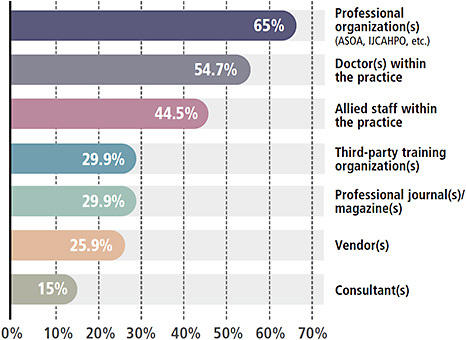
“These findings highlight the importance of organizations such as ASOA,” says Sarah L. Duval, COE, COA, at Concord Eye Center, Concord, NH. “The majority of respondents identify a desire for more practice management training and development, while simultaneously responding that they seek the majority of said training from organizations such as ASOA and IJCAHPO. I see tremendous value in these organizations, the resources they offer, and the contacts I have made.”
The ways that training programs were delivered varied as well, with more than 87% reporting online training through webinars, online courses, or social media. Sixty-seven percent reported their training was conducted live, through seminars or in-person meetings, while 64% used written materials such as textbooks or practice-generated manuals (Figure 7).

Martha C. Tello, BGS, COMT, the senior clinical educator of ophthalmic technicians at Bascom Palmer Eye Institute in Miami, appreciates the spirit of collaboration from physicians who take the opportunity to assist with training and lectures to the ophthalmic staff. It is a process that benefits everyone, she says, whether that training occurs in-person or virtually. “When our physicians teach the technicians, it’s a way to show appreciation to the clinical team for their contributions. As a physician, why not take one night a month or every quarter and spend an hour teaching? For convenience, it can be done as a streamlined event.”
Download the full report
Ophthalmic Professional subscribers have even more access to the results of our subscriber survey. Thanks to the support of OP advertisers, our comprehensive survey report is available to download at no cost. Visit our website to view the data, and please tell us what you think. What are your takeaways, and how can we improve this survey to make it even better next year?
Relying on experienced members of the staff to train new techs may be more costly in the long run than engaging a third-party training organization, according to Ms. Shuman. She notes that under current economic conditions, most practices are trying to wring the maximum productivity out of the smallest number of workers. When the responsibility for training new teammates is added to staff members who are already stressed about heavy workloads, greater anxiety results.
“When allied staff do the training, new techs are taught what to do, but not necessary why,” she says. “I think this contributes to a higher turnover rate, because we all want to go to work and feel productive. Without understanding what they’re doing ... the newer people leave. That puts greater stress on staff members because they feel that they don’t have the time to train adequately while they’re seeing the full boatload of patients.”
A holistic approach to training
The experts agree that better training can help to improve job satisfaction and mitigate the migratory effects of the Great Resignation, which has been documented since the COVID-19 pandemic. For example, between 500,000 and 600,000 health care workers quit their job each month, according to the US Bureau of Labor Statistics.1 In eye care, some of those workers are moving into new positions. More than 22% of survey respondents have been with their current employer less than 2 years (Figure 8).

“Over the last 3 years, we’re seeing a very migratory market in terms of ophthalmic technicians and practice administrators,” says Ms. Baldwin.
Different practices or organizations have different needs, so to be most effective, a training program must be specifically tailored to address those needs through investment in both clinical and administrative teams. Practices that provide such comprehensive programs are more likely to keep talented staff, says Ms. Baldwin.
“My whole mantra is, ‘train to retain,’” she says. “We need to create a pathway to success for all team members. How are we anticipating and thinking about investing in our people so that they grow and develop with our organization and better deliver on our business goals? The short answer is a proactive, planned, ongoing commitment to training and development.”
Taking staff training beyond the basics will result in better quality patient care, says Ms. Tello. “In addition to teaching ophthalmic skills that they will need to deliver patient services to highest standards — refraction, applanation, imaging — practices should also be teaching staff about best communication practices when they are onboarding. That is a leadership skill, along with decision-making and conflict resolution, that many practices could be missing.”
Ms. Tello notes that a finely tuned ophthalmic technical team will also benefit from instruction in communication best practices, including email etiquette, communication skills in dealing with patients and colleagues, and understanding policies and procedures to improve workflow and reduce stress.
“The clinical team will appreciate their practice engaging in training beyond basic ophthalmic core skills and making communication a priority” she says. “Strategic training in staff development, including mentorship, public speaking, and introduction to virtual reality, among other subjects, can instill a culture of learning and best communication practices for the current staff and new hires.
“When people leave it’s because there are stressors, such as money and incentives. But people need to feel valued,” Ms. Tello continues. “When you have someone new in your practice who shows that they’re interested in learning, it’s important to teach those leadership skills—conflict resolution, mentoring, decision-making, professionalism, obtaining goals, public speaking, communication, etc. They’re going to feel valued, knowing that the practice is spending time and resources on them. That in turn will translate into better quality of patient care.” OP
REFERENCE:
- U.S. Bureau of Labor Statistics. Table 4: Quits levels and rates by industry and region, seasonally adjusted. May 31, 2023. Accessed June 7, 2023. https://www.bls.gov/news.release/jolts.t04.htm#jolts_table4.f.1 .








